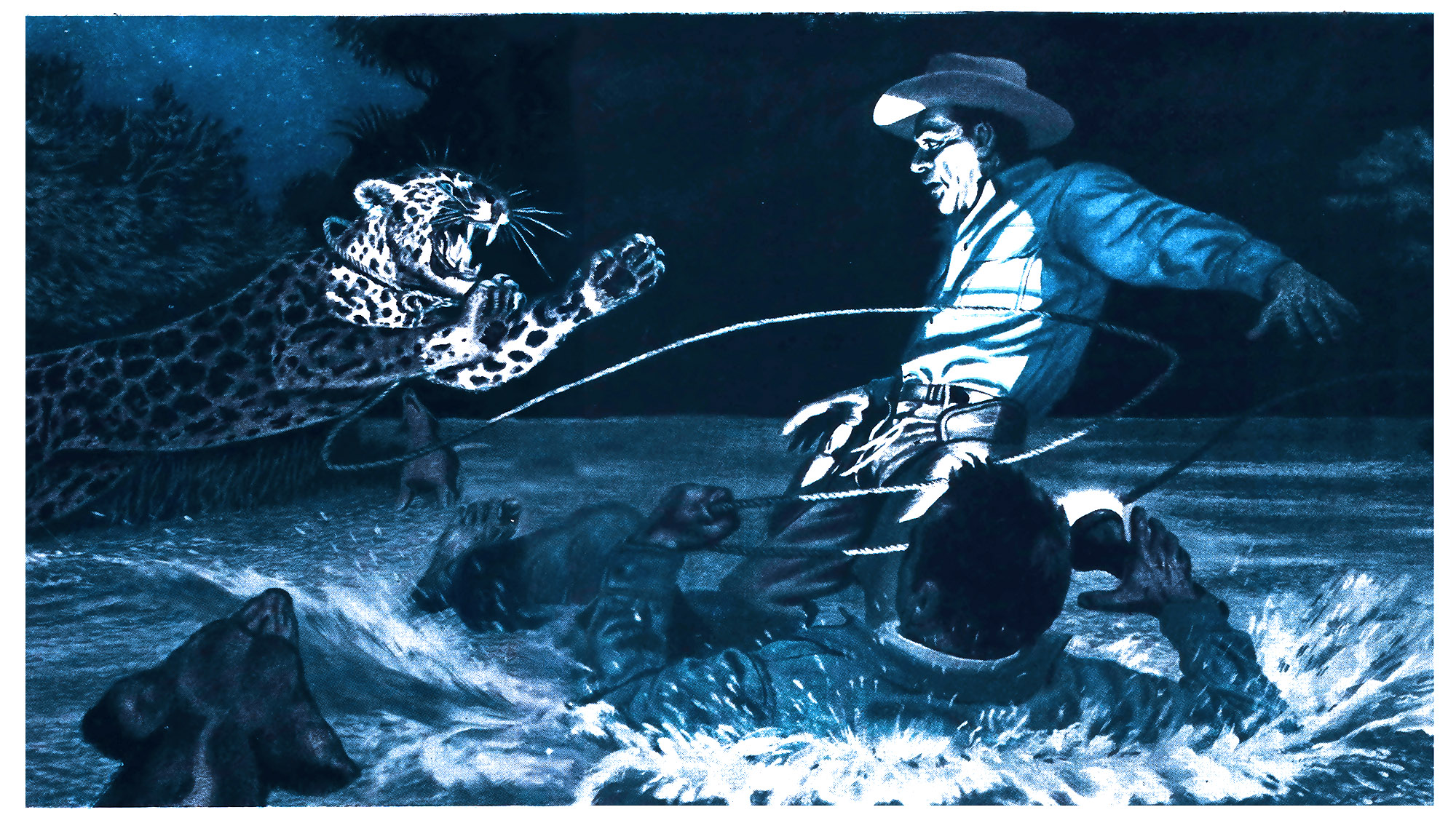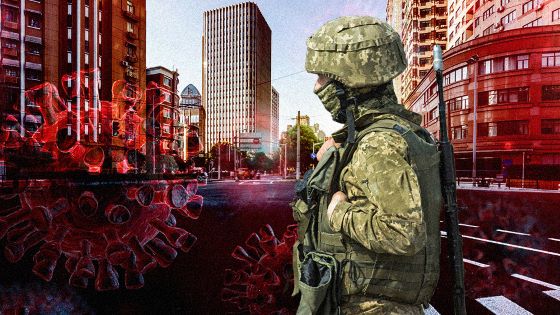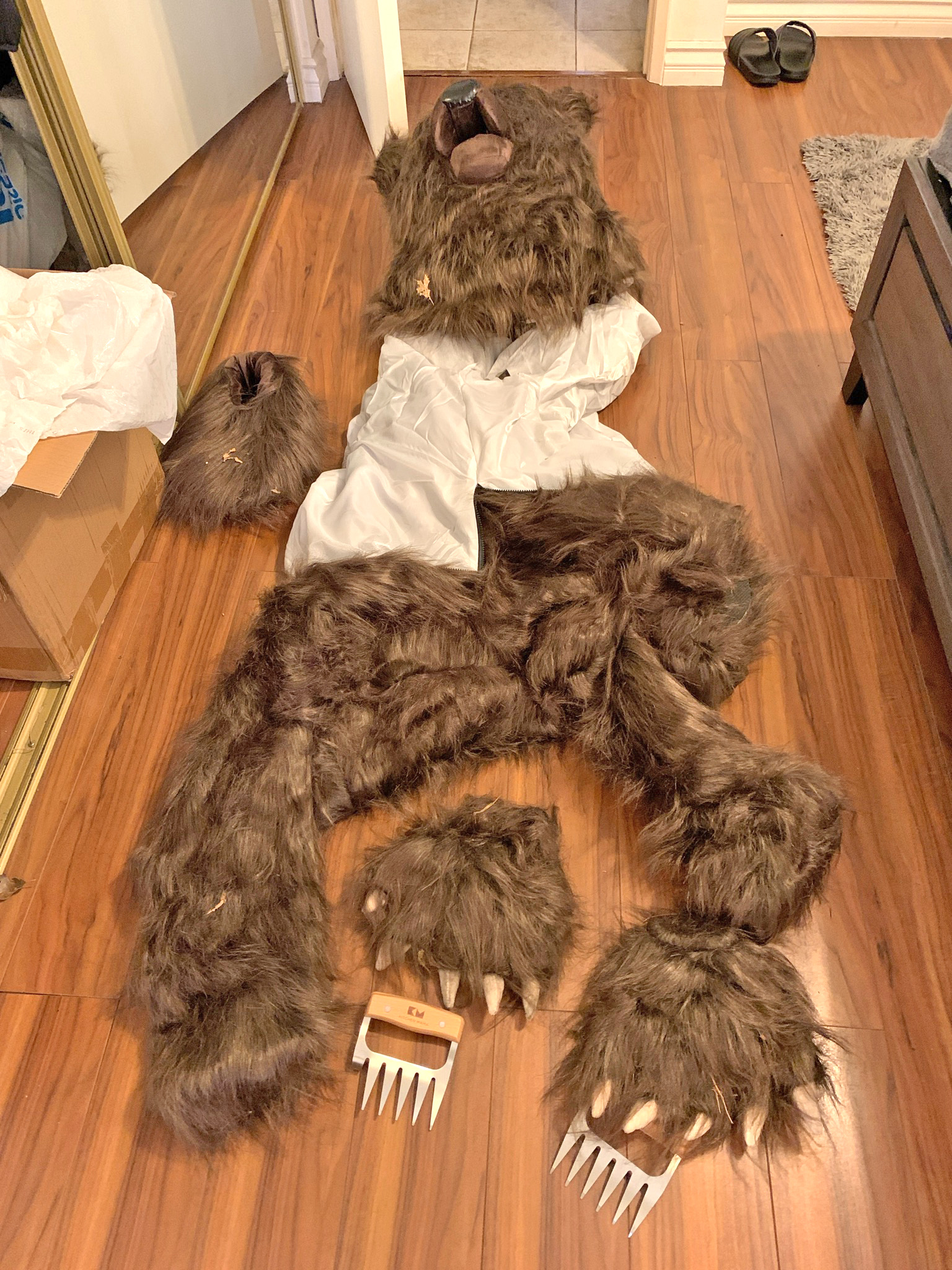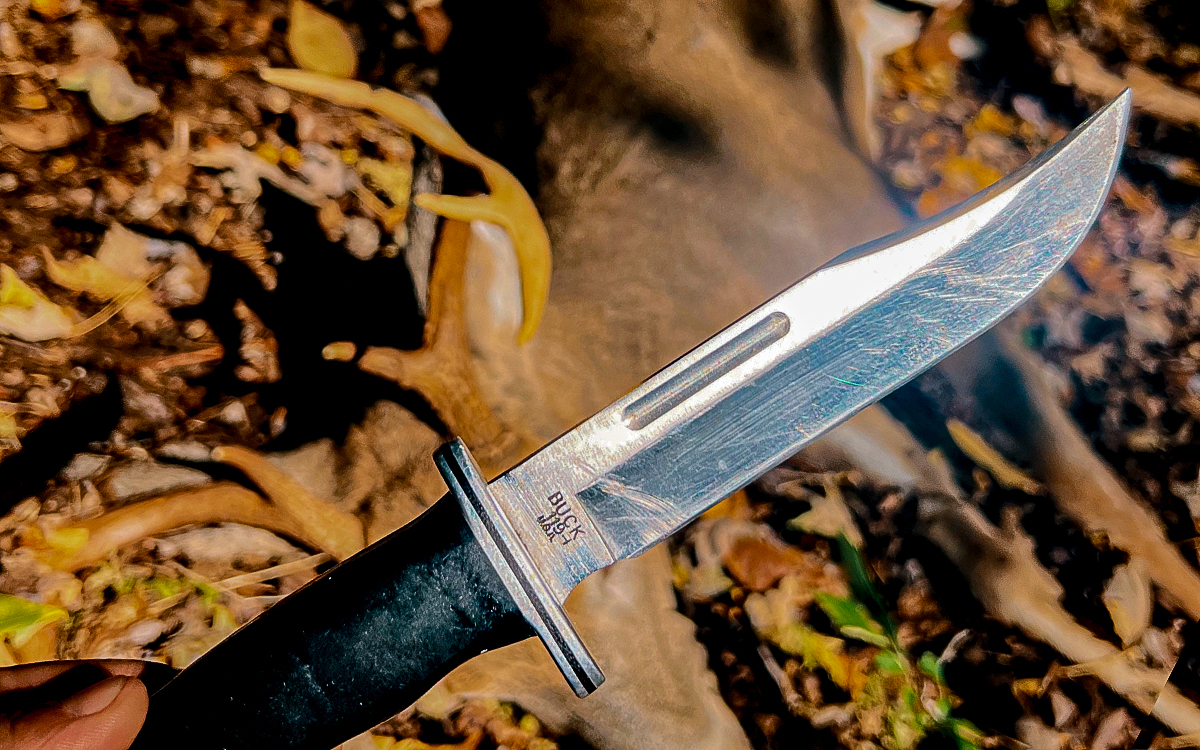I Roped a Wild Jaguar in Old Mexico

I have been mauled by grizzly bears and mountain lions. A lion bit me through the left knee and did it no good at all. Anyway, I’m not kidding myself; I know that I’m no longer as young and spry as I once was when I roped lions in and around Grand Canyon. But I’ve had a lot of experience. And I was foolish to think I could rope one of the savage matador tigres of Mexico. I got another mauling. But I still think I can do it.
I don’t know how many other men have tried roping a tigre, but it’s anything but a popular method of hunting. The tigre, or jaguar, is a big cat, the size of an African leopard. Unlike our mountain lion he holds man in no respect. In fact, he sometimes becomes a man-killer.
You put a mountain lion up into a tree and roping him isn’t too difficult. But a tigre rarely takes to a tree. Instead, when a dog pack runs him down, he flips around to face them and backs into thick jungle growth. Then heaven help the dog that makes a frontal attack.
Tigres occasionally come up from Mexico and I killed two of them in Arizona. I also got 19 — including questionable crosses — in Mexico, from Ciudad Obregon to San Blas. One of them killed several of my best dogs, so I was aware that the jaguar is a fast. deadly combatant. He prowls through tunnels in otherwise impenetrable chaparral brush and leaps without warning on his prey, dispatching it by biting through its windpipe, jugular vein, or spinal cord with his saber-like fangs.
Well, I got the notion to try roping one at night in western Mexico, using a flashlight to dazzle him and reduce the odds against me. We put our two boats into the Santiago River where the bridge of the Mazatlan-Guadalajara highway crosses it. That river flows through some excellent game country. “We” included Ignacio Zamora, a Mexican Red Cross worker, who was in my boat, and Juan Chavas, foreman of a furniture factory, who was crowded into another boat with a helper named Pete and five of the smallest hounds I’ve ever seen.
Once, after biting through the rope that ran from a tree to his neck, a mountain lion knocked me for a loop, cutting a gash in my right side that exposed my intestines. My .45 was against his head when I fired.
I couldn’t figure out the breed of those hounds but I did know they had been raised and trained for tigre hunting. Their small size and variegated colors made them ideal for work in thick jungle.
We’d gone perhaps four miles upriver when we came to a side stream that joined the main channel. The current ran slowly here. We went ashore to look around and I was astonished at the great numbers of small fish in the shallows. Tigre tracks were everywhere in the soft mud. Jaguars are great fishers and, unlike most cats, are perfectly at home in water.
I was for moving a bit downstream to make camp and then coming back after dark, when the tigres would be out fishing in full force. But Juan insisted there was an even better place about four miles farther upstream. Maybe there’d be no more tigres there, he said, but the country was more open, giving the dogs a chance to corner a big cat and me a chance to maneuver my rope. That made sense so we moved on.
The sun was still shining when we arrived at the spot Juan had in mind. We made camp under a giant live oak tree. There was a rock fireplace (Juan had camped there before), a supply of firewood, and cold, clear spring water. In front of us the Sierra Madres jutted up into the blue sky. I had hunted that country before. Once, on the north fork of the Durango, a grizzly had broken my jaw and knocked out four of my teeth. It was a case of being too close when I shot; the bear reached me before it died. The tear in my neck exposed the jugular vein. We were hundreds of miles from a doctor. My camp mates patched me up, wiring the broken jawbone together as best they could, and I lived on the broth of venison and wild turkey for a month.
Related: The Outdoor Life Vintage Cover Art Shop
Why do men persist in such dangerous pastimes? One such ordeal should be enough to send us to an armchair to do the rest of our adventuring with a book. But it gets into the blood. An animal trainer will have practically every bone in his body broken, at one time or another, and keep right on as long as he can walk. Possibly he’s no braver than a more prudent man. Maybe it’s the challenge of pitting one’s brain and ingenuity against a wild beast’s fang and claw.
While the boys were brewing coffee, Juan and I took the boat and went for a little look-see. There was a long slough running parallel with the river, and a strip of jungle between the two. On the far side of the strip, away from the river, game trails came down out of the hills. In some places there were tunnels through the chaparral.
We found prints of practically every sort of game native to that part of the country. But cat tracks predominated. (I say “cat tracks” reflectively, because Mexico has many different kinds of cats and their prints all look alike except for size. A big one may be that of a lion or a jaguar.) Most of the tracks had been made the night before but some were very fresh.
At least 1,000 ducks must have rested on the lagoon-like slough the night before, for it was littered with their feathers — evidence that the cats killed the sleeping ducks. A sleeping duck on water, with its head under its wing, is about the most helpless prey imaginable. We saw no sign of geese here, or of mallard ducks. We’d often found mallards on the lakes and streams of the high country but never anywhere along Mexico’s west coast. We were out about two hours and then returned to camp to find a nice whitetail buck hanging in a tree. Ignacio had killed it not more than 200 yards from camp. The odor of frying deer liver and bacon was tantalizing.
Supper over, we took my old coonhound horn and began practicing tigre calls. That is, Ignacio and Juan did. The grizzly that had relieved me of my teeth had also made it impossible for me to use the horn properly.
Our camp was about 500 yards downriver from where we expected to find our jaguar. The plan was to call one in close and then turn the dogs loose. If they could manage to tree the big cat, or bring him to bay, we’d close in on him. I’m right-handed, so Juan with the flashlight would keep on my left side, leaving my right arm plenty of room to swing the rope.
In the past I had found that leather chaps provide the most practical armor for the legs against the powerful claws and fangs of a cat, although they don’t give complete protection. In Mazatlan I’d bought a heavy pair made of bull hide and had a pocket made in them for my .45 handgun. I was a good hip shot with the .45 and did fairly well on targets.
In roping a lion, I don’t anticipate actual contact with him, and shooting is a last resort, done only at very close quarters. In fact, I don’t remember ever having had time to take aim at a lion while roping it. Once, after biting through the rope that ran from a tree to his neck, one knocked me for a loop, cutting a gash in my right side that exposed my intestines. My .45 was against his head when I fired. Such shooting is almost instinctive.
That had been my experience with mountain lions. What would happen with a jaguar was anybody’s guess.
The Mexican chaps were like our American variety, fastened together at the top with a leather thong — much like two tall hip boots tied together — but with plenty of play for spreading the legs in riding. That leaves a considerable space between waist and crotch uncovered, but it had never seemed important to me. Even if it had, I could scarcely have done anything about it without restricting my movements. Speed is more important than armor in roping big cats, for once they have you, nothing less than tank armor can resist their slashing claws and fangs.
We rehearsed our stunt in camp and had everything working smoothly before we took a final rest and smoke around the campfire. The sun was down and it was getting dark when we heard a coughing growl far up on the side of a high, domelike hill whose sides were covered with hardwood and chaparral. The top of this hill, we had noted earlier, was capped with solid rock, in which little vegetation could find root. That first tigre call brought an answer from a considerable distance to the south.
In a moment, dogs were all around him. He’d lunge at one, and as he did another would grab his tail or nip at a ham. The cat’s eyes were like gleaming stars.
Ignacio, Juan, and I got aboard the larger boat with five dogs. Three of them had their mouths tied shut, with slipknots for quick release. As for the other two, Ignacio held the mouth of one closed and I the other’s. That way all five dogs would be quiet until we were ready to release them.
I glanced at Ignacio; he was the only one of us who had not hunted jaguar. I wanted to see how his nerves were holding up. He had the most dangerous — if the simplest — of the helper roles and he had seemed steady enough in rehearsal. The plan was for me to get the rope secured on the tigre’s neck; then Juan and I would hold the cat while Ignacio came in from behind and put a rope on its hind leg.
There was always a chance that the tigre might bite through the rope and turn on Ignacio; then Juan and I would be powerless to do anything in the split second before the lion lashed out. Ignacio realized his danger but seemed undisturbed by the prospect. After getting the rope on the tigre’s leg he was to tie it to anything handy. Then we could stretch the big cat and I could go in and tie and gag him.
Out on the hunting grounds, Juan’s first call was perfect. An answer came from the north, apparently across the river from us, and then another from the south side of the slough, much nearer. Whether the answers came from two females, or from males warning a trespasser off their domain, we never knew, for the animals didn’t come down to the water. But it may be that the one to the north swam the river and started toward us.
We paddled over to where the large boat was resting on the mud bottom in shallow water about 50 yards from the trees on shore. It was pitch dark now — an ideal time for using our flashlight. Juan called every few minutes, achieving a far-off tone by crouching and putting the bell of the horn almost to the floor boards.
Between calls we listened intently, and after a while we heard it — the sound of a big cat sloshing through water. I was holding the mouths of two dogs shut, for Juan needed both hands to manage the call. Now one of the hounds heard the cat. He struggled desperately, got free, and was gone in a flash. I released the other hound and turned loose the three that had been gagged. Caution was useless now.
As I released the last dog Juan put the spotlight on the tigre. He seemed puzzled but not afraid as he faced the blinding glare. In a moment, dogs were all around him. He’d lunge at one, and as he did, another would grab his tail or nip at a ham. The cat’s eyes were like gleaming stars.
It looked as though we’d have to rope him right there in shallow water. But then he started backing slowly but steadily toward the jungle and finally got his rear end into the brush on dry ground. Then he settled down to fight. We were badly handicapped because we still had to stand in mud.
Up to this point everything worked about as we’d planned it. But now it would not be easy to rope him, for he had backed so far into the jungle that the brush would interfere with my loop. In the light of the torch he looked so big he took my breath away — more like a Bengal tiger than a jaguar. He must have been 10 feet long.
Juan, hanging onto the rope with me, was also trying to keep his light on the cat. But by pure accident its beam struck me full in the face for just an instant. That was all the tigre needed.
I made six or seven unsuccessful casts with the rope. Then he suddenly lunged at a dog just in time to stick its head neatly through the loop that was sailing toward him. I jerked it tight and Juan grasped the rope with me. There was 300 pounds of fury at the other end, jerking the rope like a wild horse, and it was all we could do to hold him. Yet hold him we must, for back in the chaparral Ignacio was trying to get a rope fast to the tigre’s hind leg.
Juan, hanging onto the rope with me, was also trying to keep his light on the cat. But by pure accident its beam struck me full in the face for just an instant. That was all the tigre needed. He’d located his tormentor and now he charged without delay. The light was blinding him again but it was too late.
I hardly saw him coming before he hit me. I must have yanked out my handgun and fired point blank as I staggered back from the blow, but in I truth I don’t remember firing that shot. Next I found myself sprawling in the water, not knocked out but certainly dazed. I remember thinking, “This is it,” and getting the handgun up.
Then Juan shouted, “He’s dead!” I had never heard such welcome words before. Juan helped me to my feet, and I examined the tigre with the flashlight. There was a bullet hole between his right eye and his nose.
Read Next: How to Insult Your Western Hunting Guide
We lost no dogs on that deal but several were badly cut about the head and shoulders. We doped their wounds with a strong, bluish concoction that Juan carried. By now I’d discovered that my pants above the chaps had been torn to shreds. There was a fluid running down my legs which I at first thought was water. It wasn’t; it was blood. Only then did I find that the cat had come close to ruining me.
The flesh of my lower abdomen was badly ripped. Juan managed to stanch the bleeding by putting some of his dog medicine on me. Wow! After enduring the bite of that stuff, hellfire holds no terrors for me. Then Juan bandaged me and I was able to walk to the boat. That wound gave me plenty of trouble in the next year, and I’ll always carry a scar as a memento of my first defeat in trying to rope a tigre.
Maybe my only attempt; that’s in the laps of the gods. But if I try again I’m going to arrange to have my own lap better covered.
This story, Jaguar on a Rope, first appeared in the October 1953 issue of Outdoor Life.
Read the full article here







